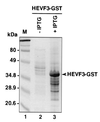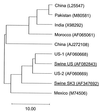Prevalence of hepatitis E virus antibodies in Canadian swine herds and identification of a novel variant of swine hepatitis E virus
- PMID: 11687465
- PMCID: PMC96251
- DOI: 10.1128/CDLI.8.6.1213-1219.2001
Prevalence of hepatitis E virus antibodies in Canadian swine herds and identification of a novel variant of swine hepatitis E virus
Abstract
Swine hepatitis E virus is a newly identified potentially zoonotic virus from pigs of particular concern for possible direct transmission to a human xenotransplant recipient by organ transplantation. In the present study, prevalence of serum antibodies to hepatitis E virus was examined in Canadian swine herds. A total of 998 serum samples collected from 6-month-old healthy slaughter hogs were examined by enzyme immunoassay and Western blot analysis for antibodies to the recombinant open reading frame 3 (ORF3) protein of hepatitis E virus expressed in Escherichia coli. These samples represented more than 80 different swine production units from five major swine-producing provinces across Canada. From this study, 594 samples (59.4%) were found to be positive for hepatitis E virus antibody. The seroprevalence was higher in Quebec (88.8%) and Ontario (80.1%) than in Alberta and Saskatchewan (38.3%). By PCR using a pair of oligonucleotide primers deduced from the ORF2 sequence of human hepatitis E virus, a specific hepatitis E virus sequence was recovered from feces of pigs. The nucleotide sequence identity between the U.S. swine hepatitis E virus and the Canadian isolate (SK3) was only 85.8%, suggesting that genotypic variations may exist in swine hepatitis E virus in North America. Among 165 serum samples collected from humans in Saskatchewan, 2.4% were found to be positive for antibodies to the hepatitis E virus ORF3 protein. Our data indicate that hepatitis E virus is highly prevalent in commercial swine populations in Canada and support the suggestion that the swine hepatitis E virus may be an important zoonotic agent for humans.
Figures




Similar articles
-
Prevalence of antibodies to hepatitis E virus among apparently healthy humans and pigs in Bali, Indonesia: Identification of a pig infected with a genotype 4 hepatitis E virus.J Med Virol. 2004 May;73(1):38-44. doi: 10.1002/jmv.20059. J Med Virol. 2004. PMID: 15042646
-
Seroprevalence and molecular detection of hepatitis E virus in Yunnan Province, China.Arch Virol. 2011 Nov;156(11):1989-95. doi: 10.1007/s00705-011-1089-6. Epub 2011 Aug 28. Arch Virol. 2011. PMID: 21874521
-
Molecular investigation of hepatitis E virus infection in domestic and miniature pigs used for medical experiments.Xenotransplantation. 2004 Nov;11(6):503-10. doi: 10.1111/j.1399-3089.2004.00170.x. Xenotransplantation. 2004. PMID: 15479459
-
[Hepatitis E as a zoonosis].Nihon Rinsho. 2004 Aug;62 Suppl 8:524-31. Nihon Rinsho. 2004. PMID: 15453377 Review. Japanese. No abstract available.
-
Epidemiology, geographical distribution, and economic consequences of swine zoonoses: a narrative review.Emerg Microbes Infect. 2013 Dec;2(12):e92. doi: 10.1038/emi.2013.87. Epub 2013 Dec 24. Emerg Microbes Infect. 2013. PMID: 26038451 Free PMC article. Review.
Cited by
-
Identification of novel human hepatitis E virus (HEV) isolates and determination of the seroprevalence of HEV in Korea.J Clin Microbiol. 2005 Jul;43(7):3042-8. doi: 10.1128/JCM.43.7.3042-3048.2005. J Clin Microbiol. 2005. PMID: 16000413 Free PMC article.
-
Porcine-derived pancreatic enzyme replacement therapy may be linked to chronic hepatitis E virus infection in cystic fibrosis lung transplant recipients.Gut. 2024 Sep 9;73(10):1702-1711. doi: 10.1136/gutjnl-2023-330602. Gut. 2024. PMID: 38621922 Free PMC article.
-
Routes of transmission of swine hepatitis E virus in pigs.J Clin Microbiol. 2004 Nov;42(11):5047-52. doi: 10.1128/JCM.42.11.5047-5052.2004. J Clin Microbiol. 2004. PMID: 15528694 Free PMC article.
-
Transmission dynamics of hepatitis E among swine: potential impact upon human infection.BMC Vet Res. 2007 May 10;3:9. doi: 10.1186/1746-6148-3-9. BMC Vet Res. 2007. PMID: 17493260 Free PMC article.
-
Detection and Phylogenetic Analysis of the Hepatitis E Virus in a Canadian Swine Production Network.Food Environ Virol. 2016 Dec;8(4):296-304. doi: 10.1007/s12560-016-9252-6. Epub 2016 Jul 15. Food Environ Virol. 2016. PMID: 27422131
References
-
- Balayan M S. Hepatitis E virus infection in Europe: regional situation regarding laboratory diagnosis and epidemiology. Clin Diagn Virol. 1993;1:1–9. - PubMed
-
- Balayan M S, Andjaparidze A G, Savinskaya S S, Ketiladze E S, Braginsky D M, Savinov A P, Poleschuk V F. Evidence for a non-A non-B hepatitis transmitted via the fecal oral route. Intervirology. 1983;20:23–31. - PubMed
-
- Balayan M S, Usmanov R K, Zamyatina D I, Karas F R. Brief report: experimental hepatitis E infection in domestic pigs. J Med Virol. 1990;32:58–59. - PubMed
-
- Berke T, Mastson D O. Reclassification of the Caliciviridae into distinct genera and exclusion of hepatitis E virus from the family on the basis of comparative phylogenetic analysis. Arch Virol. 2000;145:1421–1436. - PubMed
-
- Chandler J D, Riddell M A, Li F, Love R J, Anderson D A. Serological evidence for swine hepatitis E virus infection in Australian pig herds. Vet Microbiol. 1999;68:95–105. - PubMed
Publication types
MeSH terms
Substances
LinkOut - more resources
Full Text Sources

